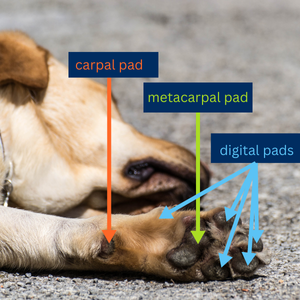Dear Izzy,
My coworkers sometimes forget that I’m a cat—until I reach out a paw to shake their hand. At first glance, cat and dog paws seem very different from human hands and feet.
I talked about that with my friend Natasha Hottmann. She’s a veterinarian at Washington State University.
She told me that a dog paw is actually super similar to a human foot. Dogs just walk on their toes—like they’re wearing invisible high heels. That’s called digitigrade locomotion.
“People think, ‘Oh, their knee is backward’ or something—but it’s not their knee,” Dr. Hottmann said. “It’s the point of their heel, which is basically the same as ours. It’s just up in the air because they’re walking on their tippy toes.”

Here’s a dog’s front paw. The back paw has only four digital pads and no carpal pad.
If you look at the underside of a dog’s paw, you’ll see four digital pads near the tip. There’s a bigger metacarpal pad below those. Most dogs have a fifth digital pad just on the front paws. It sits to the side like your thumb does.
The digital and metacarpal pads cover a dog’s toe bones. Those are the pads they walk on.
Most dogs have a furry space after the metacarpal pad on the front paws. Then they have carpal pads above that. They’re on a dog’s wrist. The bone under that pad is the same knobby bone you have in your wrist. You can feel it on the outside of your wrist. That bone is called the accessory carpal bone in dogs and cats.
Remember the dog’s heel bone that gets mistaken for a backwards knee? There’s no paw pad there. It’s the same bone you have in your heel—called the calcaneus. You can’t feel yours because, unlike dogs, you have thick fat on top of it.

In humans, the accessory carpal bone is called the pisiform.
A dog’s pads are objectively cute, but they’re not there just to make us squee. They do some big jobs.
Paw pads protect a dog’s feet.
The pads are fat and connective tissue covered with thick, durable skin. So, when the dog’s paws hit the ground, the pads absorb the shock. That keeps the bones safe.
If the ground is sharp, the tough pads protect the paws from damage. They also provide traction. They help dogs walk or run without slipping on wet, smooth or uneven surfaces.
Paw pads also help keep dogs cool.
Dogs don’t sweat like you do. Sweating works because the liquid evaporates from skin, taking body heat with it. A dog’s fur would just soak up that sweat. So, they mostly stay cool by panting.
But they do have sweat glands on their noses and paw pads. Those hairless spots ooze little bits of sweat that help keep them cool. Sometimes hot or nervous dogs leave wet footprints behind.
In case you’re curious, cats like me have the same bones and pads that dogs have. But we sometimes call our pads “toe beans.” Because they’re paws-itively adorable.
Sincerely,
Dr. Universe